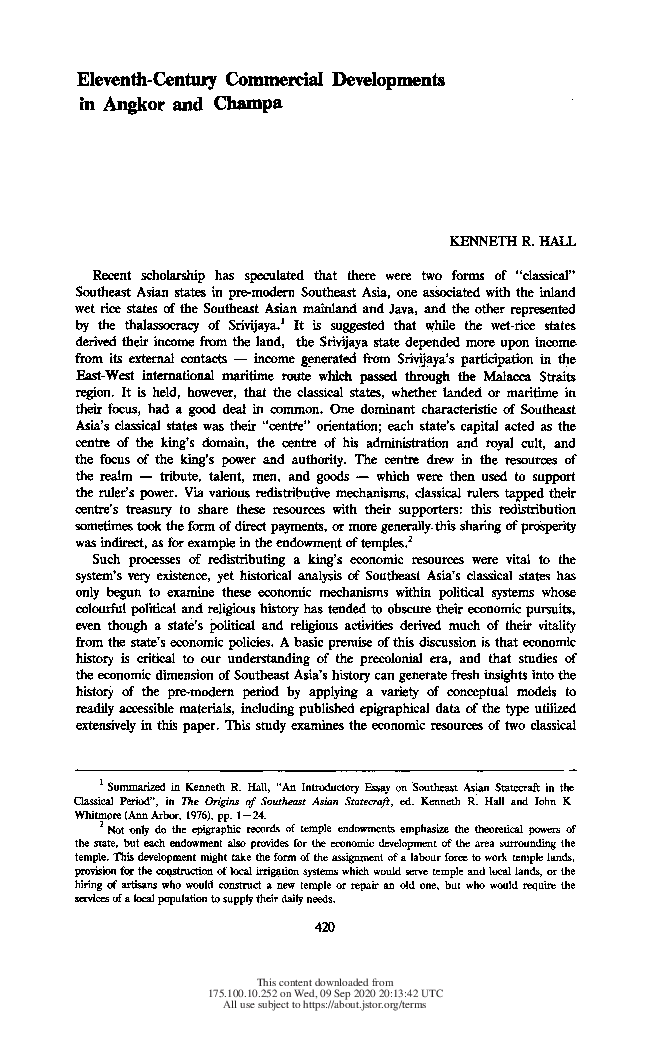Eleventh-Century Commercial Developments in Angkor and Champa
by Kenneth R. Hall
Trade and maritime rivalries during the 11th century.

- Publication
- Journal of Southeast Asian Studies, Vol. 10, No. 2, pp. 420-434 | Published by: Cambridge University Press on behalf of Department of History, National University of Singapore
- Published
- September 1979
- Author
- Kenneth R. Hall
- Pages
- 15
- Language
- English
pdf 479.7 KB
Cultural and societal differences distinguished the Khmer and Champa kingdoms from the earliest times, as well as ‘each state’s internal strength’. To quote the author, “during the tenth century and the first half of the eleventh century, the Khmer state was successfully expanding both politically and economically. The construction of Angkor’s baray and the resulting extension of agriculture, as well as the ability of the Angkor state to make even the most remote areas of its domain subject to Khmer administration, reflects significant capabilities.
“Champa’s tenth- and eleventh-century history, on the other hand, is marked by critical fluctuations. Its geographic position on the coast, as opposed to Angkor’s more protected position in the interior, seems to have contributed to Champa’s vulnerability. Cham rulers not only solicited the aid of foreign merchants and seafarers as a source of an expanded economic prosperity but also utilized the merchants’ navies for their coastal defences and expeditions of conquest.
“This relationship dictated that a strong leadership be provided by the Cham monarchy to keep these potentially disruptive forces in check. These maritime forces had traditionally assumed a double potential of either contributing to Southeast Asia’s prosperity or bringing about general disruption. We have seen the positive aspects of one relationship with these sea nomads as reflected in the seeming commercial prosperity generated by the expansion of Cham trade with China during the period being considered, but likewise there was the threat such merchant groups posed to the integrity of the state when these groups were able to establish their autonomy from central Cham authority. To maintain his state’s integrity and, as well, to demonstrate to the Vietnamese, Chinese, and his own subjects that he was quite capable of managing his domain, the Cham king intervened, taking decisive action to re-establish his firm control over Panduranga.”
Photo: Boats in Halong Bay.
Tags: Khmer Empire, Chams, Champa, trade, sea, 11th century, Vietnam, commerce
About the Author

Kenneth R. Hall
A professor of history at Ball State University, Kenneth R. Hall is a specialist in pre-1500 South and Southeast Asian history and culture, comparative urbanization and wider Indian Ocean maritime networking.
Among his numerous publications, these are particulary interesting for Angkorean researchers and lovers: A History of Early Southeast Asia: Maritime Trade and Societal Development c. 100‑1500 (2011); “Champa Ports-of-Trade Networking on the Coastline c. 300‑1500 CE” (Bangkok); “Regional Identities, Maritime Networking and Islamic Conversions in Fifteenth-Century Java“ (London);“Revisionist Study of Mainland South-East Asia’s Maritime Connections, c.100‑1500” (Delhi); “South Asia: 8th Century India Transitions” (Leeds); “Contested Histories of Ming Agency in the Java Sea, Straits of Melaka, and Bay of Bengal Region” (New York); “Knowledge Transfers in 14th and 15th Century Java” (Singapore), and “Ayutthaya’s Seventeenth-Century Deerskin Trade in the Extended Eastern Indian Ocean and South China Sea” (New York/Leeds).
He is on the advisory board of The Journal of the Economic and Social History of the Orient, and was a Fulbright Senior Scholar/Professor of comparative religion at Gadjah Mada University in Indonesia (2003 – 2004) and Southeast Asian studies at the Royal University of Phnom Penh (2012).

